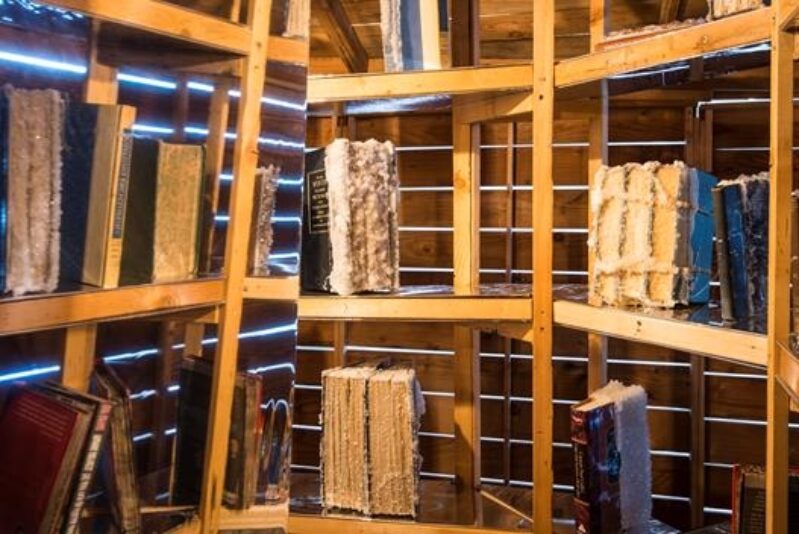Edgar Arceneaux Provokes Thoughts on Race in America
Written by TeenTix Press Corps Newsroom Writer Sofia Gerrard, and edited by Teen Editorial Staff Member Lily Williamson!

Sitting in an empty corner of The Henry Art Gallery is a small shack made from wooden slats no more than an inch thick. There are slivers of space between each board, and, despite the gallery's tall ceilings, the shack is hardly more than six feet tall. It seems almost like a relic of history, maybe the crowded house of a family on the frontier, or a shed containing hidden fugitives, but certainly not the exterior of "Library of Black Lies," one of the most thought provoking and unique pieces of modern art created by artist Edgar Arceneaux.
As you step inside the shack, you are greeted by a partially obscured mirror reflecting back an image of yourself. Shelves with books—some old, some wrapped in black tarps and tied together with string—create a labyrinth, one that is purposefully disorienting, but guides you to the center. As I walked through this labyrinth, the shack seemed to become larger, and my reflection peeked back at me, wondering where I would turn and where my path would lead. As I finally approached the center of the shack (shortcuts through the circuitous route are impossible), the books on display were no longer covered with drab tarps—instead, they sparkled, a warm yellow light glinting off the sugar crystals erupting from the pages.

Edgar Arceneaux (U.S., born 1972). Library of Black Lies. 2016 .Wood, mirrored glass, mylar, newspaper, hard-bound books, sugar crystals, lighting fixtures, audio component. Courtesy of the artist. [installation view in EdgarArceneaux: Library of Black Lies, Henry Art Gallery, University of Washington, Seattle. 2018]. Photo: Mark Woods, courtesy of the Henry.
The progression through the labyrinth to the heart of the shack is, I believe, meant to represent social progress, the difference between a person's exterior and their inner feelings and beliefs. The selection of books, ranging in topic from science to history to Bill Cosby, inspires questions about the purpose of their inclusion, and the ultimate purpose of the exhibit.
It doesn't take long to experience this exhibit (only a minute or two to walk slowly to the center) but the shed seems, despite its fixed wooden exterior, to be ever changing, growing, and evolving, practically commanding multiple passes through the exhibition. Even given this, it may be hard to justify a trip to The Henry to see just "Library of Black Lies." While the exhibit is certainly intriguing, it’s possible that one could find it hard to understand or feel connected to. This is often a pitfall of many modernist works, but seeing "Library of Black Lies" is a deeply personal experience. The viewer's entire appreciation of the work hinges on their understanding of and reaction to the exhibit.
I felt that I could have understood the exhibit better, and that if I had, it would have been a more moving experience. While viewing the piece, my emotions did shift from confusion to enjoyment, but I thought that much of the exhibit was devoid from a personal reaction. Many of my thoughts were interesting to me, yet I found myself less inspired than I usually am when viewing art. As I spent more time in the exhibit, I did begin to understand more, but this deeper understanding would have been hard to come by if I hadn’t had so much time to ponder the exhibit.

Edgar Arceneaux (U.S., born 1972). Library of Black Lies. 2016 .Wood, mirrored glass, mylar, newspaper, hard-bound books, sugar crystals, lighting fixtures, audio component. Courtesy of the artist. [installation view in EdgarArceneaux: Library of Black Lies, Henry Art Gallery, University of Washington, Seattle. 2018]. Photo: Mark Woods, courtesy of the Henry.
My experience was likely heightened by an understanding of the wrought history of race in America, which Arceneaux draws upon. Arceneaux described his view of black history in America to the LA Weekly as a progression from “slavery to Frederick Douglass to Martin Luther King Jr. to Bill Cosby and Oprah Winfrey.” This is evident in some of the books Arceneaux has chosen (Cosby’s are at the center of the labyrinth) and was certainly a projection of Arceneaux's complex relationship with race. However, it is a statement that can easily be misunderstood.
Even though it was somewhat challenging for me to interpret the piece, I was able to experience what may be the most delightful aspect of the exhibit: a childlike sense of being flooded with wonder and surrounded by fantasy. The rock candy that form the crystals on the book (which I was able to feel outside the exhibit) tempt touch, and the depth created by the mirrors and lighting casts shadows that allude to mystery and complexity. Even setting aside the societal importance of "Library of Black Lies," the sheer beauty of it is enough to invite praise, and a visit.
The Teen Editorial Staff is made up of 5 teens who curate the review portion of the TeenTix blog and manage the TeenTix Newsroom. More information about the Teen Editorial Staff can be found HERE.
The TeenTix Press Corps promotes critical thinking, communication, and information literacy through criticism and journalism practice for teens. For more information about the Press Corps program see HERE.


